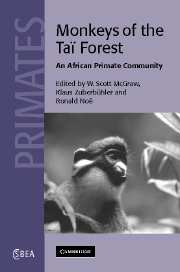Book contents
- Frontmatter
- Contents
- List of Contributors
- Preface
- 1 The monkeys of the Taï forest: an introduction
- Part I Social behavior
- 2 The social systems of the guenons
- 3 How small-scale differences in food competition lead to different social systems in three closely related sympatric colobines
- 4 The structure of social relationships among sooty mangabeys in Taï
- Part II Anti-predation strategies
- Part III Habitat use
- Part IV Conservation
- Appendix
- Index
- Plate section
- References
4 - The structure of social relationships among sooty mangabeys in Taï
Published online by Cambridge University Press: 30 July 2009
- Frontmatter
- Contents
- List of Contributors
- Preface
- 1 The monkeys of the Taï forest: an introduction
- Part I Social behavior
- 2 The social systems of the guenons
- 3 How small-scale differences in food competition lead to different social systems in three closely related sympatric colobines
- 4 The structure of social relationships among sooty mangabeys in Taï
- Part II Anti-predation strategies
- Part III Habitat use
- Part IV Conservation
- Appendix
- Index
- Plate section
- References
Summary
Introduction
Living in groups has both advantages and disadvantages. Being in a social group may decrease vulnerability to predation or increase acquisition of certain resources, but it may also increase intra-group competition for food, mates, and sleeping sites and lead to a higher risk of disease or infanticide (reviewed in Krebs & Davies 1993). The optimal size and structure of social groups is generally thought to be a balance between the costs and benefits associated with sociality.
The evolution of sociality may be directly relevant to the evolution of cognitive skills. Recent research suggests that the primate brain evolved as an adaptation to cope with the social complexity that results from competition within a framework of kinship networks, friendships, dominance hierarchies, and triadic alliances (the “social brain hypothesis”). As group size increases, the number of triadic relations explodes and the need for triadic knowledge to choose the best behavioral strategies places high demands on individuals, which could in itself offer an explanation for the large primate brain (Seyfarth & Cheney 2001).
Sooty mangabeys live in large groups (over 100 animals), are terrestrial and forest dwelling and form-differentiated relationships among group members. All of these features make them ideal subjects with which to test the “social brain” hypothesis. However, before we consider the social intelligence of sooty mangabeys, we need to understand how dominance rank, competition, affiliation, and migration shape the pattern of interactions among females and males.
- Type
- Chapter
- Information
- Monkeys of the Taï ForestAn African Primate Community, pp. 109 - 130Publisher: Cambridge University PressPrint publication year: 2007
References
- 4
- Cited by



